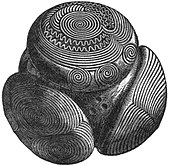Prehistoric art in Scotland
Surviving metalwork includes gold lunula or neckplates, jet beaded necklaces and elaborate weaponry, such as leaf swords and ceremonial shields of sheet bronze.Art created in mediums such as sand, bark, hides and textiles has not normally endured, while less-perishable materials, such as rock, stone, bone, ivory (and to a lesser extent wood), later pottery and metal, are more likely to be extant.More cautiously, Paul Mellars suggests that the relative rarity of these works means they cannot be seen as integral to early human society and evidence of an artistic culture.[2] Günter Berghaus argues that these works have often been approached with a set of post-Renaissance aesthetic values that distinguish between artists and craftsman and art and artifact, although these categories are not universal and may be inappropriate for understanding prehistoric society.[5] Scotland was occupied by Mesolithic hunter-gatherers from around 8500 BCE,[6] who were highly mobile boat-using people making tools from bone, stone and antlers.[12] Probably the oldest surviving portable visual art from Scotland are carved stone balls, or petrospheres, that date from the late Neolithic era.Most are from modern Aberdeenshire,[13] but a handful of examples are known from Iona, Skye, Harris, Uist, Lewis, Arran, Hawick, Wigtownshire and fifteen from Orkney, five of which were found at the Neolithic village of Skara Brae.[16] Pottery appeared in the Neolithic period once hunters and gatherers transitioned to a sedentary lifestyle, until then they needed to use lightweight, mobile containers.The figurine's face has two dots for eyes, heavy brows and an oblong nose and a pattern of hatches on the body could represent clothing.[31] There is evidence of cellular round houses of stone in Shetland[32] and wooden crannogs, roundhouses partially or entirely built on artificial islands.The slab is engraved with a spiral and has an axehead pecked into the underside, and underneath there are grave goods of a copper dagger with leather scabbard and a carved wooden bowl.[38] Jet beaded necklaces strung in a crescent shape have been found at sites including Poltalloch and Melfort in Argyll and Aberlemno in Angus.[46] The Torrs Pony-cap and Horns are perhaps the most impressive of the relatively few finds of La Tène decoration from Scotland, and indicate links with Ireland and southern Britain.Two demonstrate common styles found in Scotland and Ireland, but the other two indicate workmanship from what is now southern France, and the Greek and Roman worlds.[61] The Staffordshire Moorlands Pan is a second-century Romano-British trulla apparently decorated as a souvenir for a soldier who had served on Hadrian's Wall, and probably made locally.[62] A number of items were also found in the Sculptor's Cave, Coversea in Morayshire, including Roman pottery, rings, bracelets, needles and coins, some of which had been re-used for ornaments.





Torrs Pony-cap and HornsNational Museum of Scotlandvisual artRomansMedieval eraportable artcarved stone ballsNeolithicLinks of NoltlandWestray WifeBronze Agecup and ring marksKilmartinbattle-axesgold lunulaleaf swordsIron AgeLa TèneStirling torcscarnyxCramond Lionessprehistoric artAlexander MarshackPaul MellarsColin Renfrewrock artrites of initiationvision queststotemicnotationanthropomorphicStone AgeMesolithicKnap of HowarPapa Westraychambered cairnMaeshoweStennessportable visual artpetrospheresHarrisHawickWigtownshireOrkneySkara BraePierowallWestrayNewgrangemaceheadsUnstan wareUnstan Chambered CairnMainlandOrkney IslandsTomb of the EaglesSouth RonaldsayMidhoweRousayBalbridieWestern IslesEilean Domhnuillgrooved warecrannogshill fortsWemyss CaveLanarkshireKincardinesite at ForteviotAberlemnoKincardineshireMigdale HoardSkibo CastleBallachulish figureBallachulishroundhousesLake NeuchâtelStichillMortonhallscabbardCulbin SandsDeskfordGundestrup CauldronCoupar AngusScotland during the Roman EmpireRoman artCramond Roman FortSouthern UplandsSolway FirthHadrian's WallFirth of ClydeAntonine WallApolloFortunaBearsdenHawkshawreliefBrigantiaDumfriesshireNewstead HelmetStaffordshire Moorlands PantrullaSculptor's CaveThe ScotsmanD. W. HardingWayback MachineNational Museums ScotlandMegaw, R., and Megaw, J. V. S.Prehistoric ScotlandKilmartin GlenShetlandArchitectureAtlantic roundhouseCourt cairnCrannogHillfortsRoman eraWheelhouseAgricultureCaledoniansCaereniCarnonacaeCornoviiCreonesDamnoniiDecantaeMaeataeNovantae